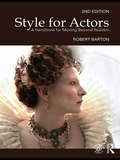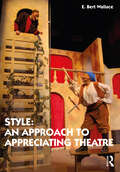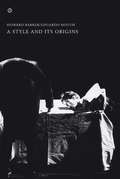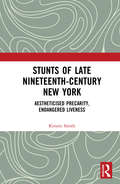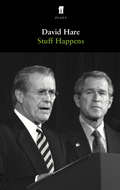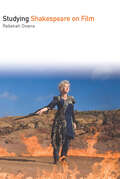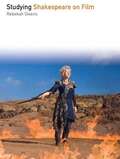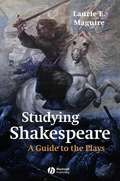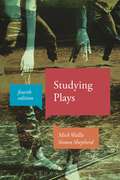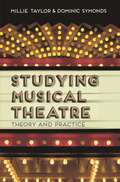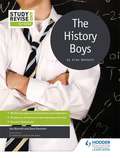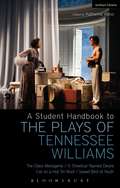- Table View
- List View
Stylistics and Shakespeare's Language: Transdisciplinary Approaches (Advances in Stylistics)
by Mireille Ravassat Jonathan CulpeperThis innovative volume testifies to the current revived interest in Shakespeare's language and style and opens up new and captivating vistas of investigation. Transcending old boundaries between literary and linguistic studies, this engaging collaborative book comes up with an original array of theoretical approaches and new findings. The chapters in the collection capture a rich diversity of points of view and cover such fields as lexicography, versification, dramaturgy, rhetorical analyses, cognitive and computational corpus-based stylistic studies, offering a holistic vision of Shakespeare's uses of language. The perspective is deliberately broad, confronting ideas and visions at the intersection of various techniques of textual investigation. Such novel explorations of Shakespeare's multifarious artistry and amazing inventiveness in his use of language will cater for a broad range of readers, from undergraduates, postgraduates, scholars and researchers, to poetry and theatre lovers alike.
Style in Hamlet
by Maurice CharneyShakespeare intended his plays to be seen, not read. With this thought uppermost in mind, Charney offers here a provocative analysis of Hamlet, the most stylistically inventive of all Shakespeare's plays, strictly in terms of its style-by which he means the distinct modes of expression used by the playwright in accomplishing his dramatic ends. Careful consideration is given to the stagecraft of the play, to lighting and sound effects, gesture and scenery. The play’s imagery is discussed with attention to its style as well as to its content. Each of the three main characters is examined in terms of his unique mode of expression. Among the interesting discoveries this approach allows is a new perspective on the character of Hamlet, who is found to have four distinct styles which he employs as the occasion demands.Originally published in 1969.The Princeton Legacy Library uses the latest print-on-demand technology to again make available previously out-of-print books from the distinguished backlist of Princeton University Press. These editions preserve the original texts of these important books while presenting them in durable paperback and hardcover editions. The goal of the Princeton Legacy Library is to vastly increase access to the rich scholarly heritage found in the thousands of books published by Princeton University Press since its founding in 1905.
Style For Actors 2nd Edition: A Handbook for Moving Beyond Realism
by Robert Barton"Style is a journey from tourist to native. It is living in the world of the play, not just visiting it." - from Chapter One Anyone who has ever struggled with capes, fans, swords, doublets and crinolines should make Style for Actors 2nd Edition their constant companion. Robert Barton has completely updated his award winning handbook for the 21st century with contemporary references and up-to-date illustrations. This is the definitive guide to roles in historical drama. The past is a foreign country, and this outstanding book is concerned with exploring it from the actor’s point of view. Specific guides range from Greek, Elizabethan, Restoration and Georgian theatre to more contemporary stylings, including Futurism, Surrealism and Postmodernism. Barton takes great care to present the actor with the roles and genres that will most commonly confront them. His analysis moves from entire genres to specific scenes and characters. A huge resource of nearly 150 practical exercises helps a newfound understanding of style to make the leap from page to performance.
Style For Actors: A Handbook for Moving Beyond Realism
by Robert Barton"Style is a journey from tourist to native. It is living in the world of the play, not just visiting it." - from Chapter One Anyone who has ever struggled with capes, fans, swords, doublets and crinolines should make Style for Actors 2nd Edition their constant companion. Robert Barton has completely updated his award winning handbook for the 21st century with contemporary references and up-to-date illustrations. This is the definitive guide to roles in historical drama. The past is a foreign country, and this outstanding book is concerned with exploring it from the actor’s point of view. Specific guides range from Greek, Elizabethan, Restoration and Georgian theatre to more contemporary stylings, including Futurism, Surrealism and Postmodernism. Barton takes great care to present the actor with the roles and genres that will most commonly confront them. His analysis moves from entire genres to specific scenes and characters. A huge resource of nearly 150 practical exercises helps a newfound understanding of style to make the leap from page to performance.
Style: An Approach to Appreciating Theatre
by E. Bert WallaceStyle: An Approach to Appreciating Theatre offers brief, readable chapters about the basics of theatre as a starting point for discussion, and provides new adaptations of classic plays that are both accessible to students learning about theatre and fit for production. In this text, style is the word used to describe the various ways in which theatre is done in real space and time by humans in the physical presence of other humans. The book uses style, the "liveness" of theatre that makes it distinct from literature or history, as a lens to see how playwrights, directors, designers, and actors bring scripts to life on stage. Rather than focusing on theatre history or literary script analysis, it emphasizes actual theatrical production through examples and explores playscripts illustrating four theatrical styles: Realism, Theatricalism, Expressionism, and Classicism. Susan Glaspells Realistic play Trifles is presented as written, while The Insect Play by the Brothers apek, The Hairy Ape by Eugene ONeill, and Antigone by Sophocles are original, full-length adaptions. Style: An Approach to Appreciating Theatre is the perfect resource for students of Theatre Appreciation, Introduction to Theatre, Theatrical Design, and Stagecraft courses.
A Style and Its Origins
by Howard BarkerHoward Barker's alter-ego Eduardo Houth first materialised as the photographer of publicity images for Barker's theatre company The Wrestling School, one of many fictional identities assumed by the playwright to screen a range of his activities, including set and costume design.Writing of himself in the third person and in the historic tense, Barker/Houth achieves a fluency and an uncommon measure of objectivity, though objectivity is scarcely the sole intention. The result is a unique exercise in self-description, partisan but without the shrill self-justification so common in a mere autobiography. Barker/Houth's A Style and its Origins is very much a literary creation; it is also a totally original document and a rich history of the dramatist and his aesthetic.
Style: An Approach To Appreciating Theatre
by E. Bert WallaceStyle: An Approach to Appreciating Theatre offers brief, readable chapters about the basics of theatre as a starting point for discussion, and provides new adaptations of classic plays that are both accessible to students learning about theatre and fit for production. In this text, style is the word used to describe the various ways in which theatre is done in real space and time by humans in the physical presence of other humans. The book uses style, the "liveness" of theatre that makes it distinct from literature or history, as a lens to see how playwrights, directors, designers, and actors bring scripts to life on stage. Rather than focusing on theatre history or literary script analysis, it emphasizes actual theatrical production through examples and explores playscripts illustrating four theatrical styles: Realism, Theatricalism, Expressionism, and Classicism. Susan Glaspells Realistic play Trifles is presented as written, while The Insect Play by the Brothers apek, The Hairy Ape by Eugene ONeill, and Antigone by Sophocles are original, full-length adaptions. Style: An Approach to Appreciating Theatre is the perfect resource for students of Theatre Appreciation, Introduction to Theatre, Theatrical Design, and Stagecraft courses.
Stunts of Late Nineteenth-Century New York: Aestheticised Precarity, Endangered Liveness
by Kirstin SmithStunts of Late Nineteenth- Century New York: Aestheticised Precarity, Endangered Liveness examines the emergence of stunts in the media, politics, sport and art of New York at the turn of the twentieth century. This book investigates stunts in sport, media and politics, demonstrating how these risky performances tapped into anxieties and fantasies concerning work, freedom, gendered/ raced/ classed bodies and the commodifi cation of human life. Its case studies examine bridge jumping, extreme walking contests, stunt journalists such as Nellie Bly, and cycling feats including Annie Londonderry’s round- the- world venture. Supported by extensive archival research and Performance Studies theorisations of precarity, liveness and surrogation, Smith theorises an under- examined form which is still prevalent in art, politics and commerce, to show what stunts reveal about value, risk and human life. Suitable for scholars and practitioners across a range of subjects, from Performance Studies to gender studies, to media studies, Stunts of Late Nineteenth- Century New York explores how stunts turned everyday precarity into a spectacle.
Stunts of Late Nineteenth-Century New York: Aestheticised Precarity, Endangered Liveness
by Kirstin SmithStunts of Late Nineteenth- Century New York: Aestheticised Precarity, Endangered Liveness examines the emergence of stunts in the media, politics, sport and art of New York at the turn of the twentieth century. This book investigates stunts in sport, media and politics, demonstrating how these risky performances tapped into anxieties and fantasies concerning work, freedom, gendered/ raced/ classed bodies and the commodifi cation of human life. Its case studies examine bridge jumping, extreme walking contests, stunt journalists such as Nellie Bly, and cycling feats including Annie Londonderry’s round- the- world venture. Supported by extensive archival research and Performance Studies theorisations of precarity, liveness and surrogation, Smith theorises an under- examined form which is still prevalent in art, politics and commerce, to show what stunts reveal about value, risk and human life. Suitable for scholars and practitioners across a range of subjects, from Performance Studies to gender studies, to media studies, Stunts of Late Nineteenth- Century New York explores how stunts turned everyday precarity into a spectacle.
Stuff Happens: A Play (Faber Drama Ser.)
by David HareStuff happens... And it's untidy, and freedom's untidy, and free people are free to make mistakes and commit crimes and do bad things.'The famous response of Donald Rumsfeld, American Secretary of Defense, to the looting of Baghdad, at a press conference on 11 April 2003, provides the title for a new play, specially written for the Olivier Theatre, about the extraordinary process leading up to the invasion of Iraq.How does the world settle its differences, now there is only one superpower? What happens to leaders risking their credibility with sceptical publics? From events which have dominated international headlines for the last two years David Hare has fashioned both a historical narrative and a human drama about the frustrations of power and the limits of diplomacy.Stuff Happens premiered at the National Theatre, London, in 2004 season and has subsequently been performed around the world. In April 2006, it was given its New York premiere at the Public Theater in this new, slightly updated text.
Studying Shakespeare on Film (Studying Films)
by Rebekah OwensAimed at newcomers to literature and film, this book is a guide for the analysis of Shakespeare on film. Starting with an introduction to the main challenge faced by any director—the early-modern language—there follows exemplars for examining how that challenge is met using as case studies twelve films most often used in classroom teaching, including Romeo and Juliet, Macbeth, and The Tempest.The first chapter explores how a director can tell the story in a setting that embraces the expectations of realism in cinema, but still pays homage to the theatrical origins of the work. The second chapter discusses films in which the setting provides a visual analogy with the preoccupations of the story, but not at the expense of Shakespeare's language. The third chapter extends this to show how some films use recent history as a setting, adding a further layer of meaning to the story from the cultural resonances associated with that historical past. These films also rely on an assumption that Shakespeare is so well-known as to form a distinctive, easily recognized brand in the cinema marketplace. Thus, his work can be reimagined in completely different genres such as those films that are the subject of the final chapter.
Studying Shakespeare on Film (Studying Films)
by Rebekah OwensAimed at newcomers to literature and film, this book is a guide for the analysis of Shakespeare on film. Starting with an introduction to the main challenge faced by any director—the early-modern language—there follows exemplars for examining how that challenge is met using as case studies twelve films most often used in classroom teaching, including Romeo and Juliet, Macbeth, and The Tempest.The first chapter explores how a director can tell the story in a setting that embraces the expectations of realism in cinema, but still pays homage to the theatrical origins of the work. The second chapter discusses films in which the setting provides a visual analogy with the preoccupations of the story, but not at the expense of Shakespeare's language. The third chapter extends this to show how some films use recent history as a setting, adding a further layer of meaning to the story from the cultural resonances associated with that historical past. These films also rely on an assumption that Shakespeare is so well-known as to form a distinctive, easily recognized brand in the cinema marketplace. Thus, his work can be reimagined in completely different genres such as those films that are the subject of the final chapter.
Studying Shakespeare Adaptation: From Restoration Theatre to YouTube
by Pamela Bickley Jenny StevensShakespeare's plays have long been open to reimagining and reinterpretation, from John Fletcher's riposte to The Taming of the Shrew in 1611 to present day spin-offs in a whole range of media, including YouTube videos and Manga comics. This book offers a clear route map through the world of adaptation, selecting examples from film, drama, prose fiction, ballet, the visual arts and poetry, and exploring their respective political and cultural interactions with Shakespeare's plays. 36 specific case studies are discussed, three for each of the 12 plays covered, offering additional guidance for readers new to this important area of Shakespeare studies.The introduction signals key adaptation issues that are subsequently explored through the chapters on individual plays, including Shakespeare's own adaptive art and its Renaissance context, production and performance as adaptation, and generic expectation and transmedial practice. Organized chronologically, the chapters cover the most commonly studied plays, allowing readers to dip in to read about specific plays or trace how technological developments have fundamentally changed ways in which Shakespeare is experienced. With examples encompassing British, North American, South and East Asian, European and Middle Eastern adaptations of Shakespeare's plays, the volume offers readers a wealth of insights drawn from different ages, territories and media.
Studying Shakespeare Adaptation: From Restoration Theatre to YouTube
by Pamela Bickley Jenny StevensShakespeare's plays have long been open to reimagining and reinterpretation, from John Fletcher's riposte to The Taming of the Shrew in 1611 to present day spin-offs in a whole range of media, including YouTube videos and Manga comics. This book offers a clear route map through the world of adaptation, selecting examples from film, drama, prose fiction, ballet, the visual arts and poetry, and exploring their respective political and cultural interactions with Shakespeare's plays. 36 specific case studies are discussed, three for each of the 12 plays covered, offering additional guidance for readers new to this important area of Shakespeare studies.The introduction signals key adaptation issues that are subsequently explored through the chapters on individual plays, including Shakespeare's own adaptive art and its Renaissance context, production and performance as adaptation, and generic expectation and transmedial practice. Organized chronologically, the chapters cover the most commonly studied plays, allowing readers to dip in to read about specific plays or trace how technological developments have fundamentally changed ways in which Shakespeare is experienced. With examples encompassing British, North American, South and East Asian, European and Middle Eastern adaptations of Shakespeare's plays, the volume offers readers a wealth of insights drawn from different ages, territories and media.
Studying Shakespeare: A Practical Introduction
by Katherine Armstrong Graham AtkinThis book is a concise single volume guide to studying Shakespeare, covering practical as well as theoretical issues. The text deals with the major topics on a chapter-by-chapter basis, starting with why we study Shakespeare, through Shakespeare and multimedia, to a final chapter on Shakespeare and Theory. Current trends and recent developments in Shakespearean studies are also discussed, with an emphasis on the contextualisation of Shakespeare, historical appropriations of his work and the debate concerning his place in the literary canon. Extensive reference is made to a variety of developing media, e.g. film, audio cassette, video, CD-Rom and global digital networks, bringing the study of Shakespeare into the twentieth century.
Studying Shakespeare: A Practical Introduction
by Katherine Armstrong Graham AtkinThis book is a concise single volume guide to studying Shakespeare, covering practical as well as theoretical issues. The text deals with the major topics on a chapter-by-chapter basis, starting with why we study Shakespeare, through Shakespeare and multimedia, to a final chapter on Shakespeare and Theory. Current trends and recent developments in Shakespearean studies are also discussed, with an emphasis on the contextualisation of Shakespeare, historical appropriations of his work and the debate concerning his place in the literary canon. Extensive reference is made to a variety of developing media, e.g. film, audio cassette, video, CD-Rom and global digital networks, bringing the study of Shakespeare into the twentieth century.
Studying Shakespeare: A Guide to the Plays
by Laurie MaguireThis engaging book draws on all of Shakespeare's plays to show they can still be used as a guide to life. Introduces beginning students and general readers to Shakespeare's plays by highlighting the connections between the issues addressed by the plays and those of our own time. Focuses on the characters, situations and stories in Shakespeare which are still familiar today. Shows how Shakespeare's plays illustrate some of life's most familiar stories - love and obsession, parents and children, sex and politics, suffering and revenge Makes Shakespeare’s plays accessible to the widest possible audience.
Studying Plays
by Mick Wallis Simon ShepherdNow in its 4th edition, this is an accessible and comprehensive introduction to the critical study of drama. Using familiar examples of classic and contemporary works such as Shakespeare's King Lear, Ibsen's A Doll's House and Timberlake Wertenbaker's Our Country's Good, the book explores the essential elements of play texts, from character, dialogue and plot to theatrical space. With more in depth guidance on how to study plays in and as performance, both live and in recordings available online, the 4th edition of Studying Plays now includes: · new examples throughout the book drawn from a range of 21st-century plays by established and emergent writers for diverse theatres and companies · new explorations of how plays structure and engage audience response · a complete new section on the analysis of theatre of witness and testimony; monodrama; and postdramatic texts.
Studying Plays
by Mick Wallis Simon ShepherdNow in its 4th edition, this is an accessible and comprehensive introduction to the critical study of drama. Using familiar examples of classic and contemporary works such as Shakespeare's King Lear, Ibsen's A Doll's House and Timberlake Wertenbaker's Our Country's Good, the book explores the essential elements of play texts, from character, dialogue and plot to theatrical space. With more in depth guidance on how to study plays in and as performance, both live and in recordings available online, the 4th edition of Studying Plays now includes: · new examples throughout the book drawn from a range of 21st-century plays by established and emergent writers for diverse theatres and companies · new explorations of how plays structure and engage audience response · a complete new section on the analysis of theatre of witness and testimony; monodrama; and postdramatic texts.
Studying Musical Theatre: Theory and Practice
by M. Taylor D. SymondsThis lively textbook provides a comprehensive overview of the history, theory and practice of this popular theatre form. Bringing critical theory and musical theatre together, Millie Taylor and Dominic Symonds explore the musical stage from a broad range of theoretical perspectives. Part 1 focuses on the way we understand musicals as texts and Part 2 then looks at how musical theatre negotiates its position in the wider world. Part 3 recognises the affiliations of various communities with the musical stage, and finally part 4 unravels the musical’s relationship with time, space, intertextuality and entertainment. Written by leading experts in Musical Theatre and Drama, Taylor and Symonds utilise their wealth of knowledge to engage and educate the reader on this diverse subject. With its accessible and extensive content, this text is the ideal accompaniment to any study of musical theatre internationally: an essential tool for students of all levels, lecturers, practitioners and enthusiasts alike.
Studying Disability Arts and Culture: An Introduction
by Petra KuppersIn this accessible introduction to the study of Disability Arts and Culture, Petra Kuppers foregrounds themes, artists and theoretical concepts in this diverse field. Complete with case studies, exercises and questions for further study, the book introduces students to the work of disabled artists and their allies, and explores artful responses to living with physical, cognitive, emotional or sensory difference. Engaging readers as cultural producers, Kuppers provides useful frameworks for critical analysis and encourages students to explore their own positioning within the frames of gender, race, sexuality, class and disability. Comprehensive and accessible, this is an essential handbook for undergraduate students or anyone interested in disabled bodies and minds in theatre, performance, creative writing, art and dance.
Study and Revise for GCSE: The History Boys For Gcse
by Sue Bennett Dave StockwinExam Board: AQA, WJEC, WJEC EduqasLevel: GCSE (9-1)Subject: English literatureFirst teaching: September 2015First exams: Summer 2017Enable students to achieve their best grade in GCSE English Literature with this year-round course companion; designed to instil in-depth textual understanding as students read, analyse and revise The History Boys throughout the course.This Study and Revise guide:- Increases students' knowledge of The History Boys as they progress through the detailed commentary and contextual information written by experienced teachers and examiners- Develops understanding of plot, characterisation, themes and language, equipping students with a rich bank of textual examples to enhance their exam responses- Builds critical and analytical skills through challenging, thought-provoking questions that encourage students to form their own personal responses to the text- Helps students maximise their exam potential using clear explanations of the Assessment Objectives, annotated sample student answers and tips for reaching the next grade- Improves students' extended writing techniques through targeted advice on planning and structuring a successful essay- Provides opportunities for students to review their learning and identify their revision needs with knowledge-based questions at the end of each chapter
Study and Revise: A Streetcar Named Desire for AS/A-level (PDF)
by Nicola OnyettEnable students to achieve their best grade in AS/A-level English Literature with this year-round course companion; designed to instil in-depth textual understanding as students read, analyse and revise A Streetcar Named Desire throughout the course. This Study and Revise guide: - Increases students' knowledge of A Streetcar Named Desire as they progress through the detailed commentary and contextual information written by experienced teachers and examiners - Develops understanding of characterisation, themes, form, structure and language, equipping students with a rich bank of textual examples to enhance their coursework and exam responses - Builds critical and analytical skills through challenging, thought-provoking questions and tasks that encourage students to form their own personal responses to the text - Extends learning and prepares students for higher-level study by introducing critical viewpoints, comparative references to other literary works and suggestions for independent research - Helps students maximise their exam potential using clear explanations of the Assessment Objectives, sample student answers and examiner insights - Improves students' extended writing techniques through targeted advice on planning and structuring a successful essay
Study and Revise: Romeo and Juliet for GCSE (PDF)
by Jane SheldonExam Board: AQA, OCR, Edexcel, WJEC Eduqas Level: GCSE (9-1) Subject: English literature First teaching: September 2015 First exams: Summer 2017 Enable students to achieve their best grade in GCSE English Literature with this year-round course companion; designed to instil in-depth textual understanding as students read, analyse and revise Romeo and Juliet throughout the course. This Study and Revise guide: - Increases students' knowledge of Romeo and Juliet as they progress through the detailed commentary and contextual information written by experienced teachers and examiners - Develops understanding of plot, characterisation, themes and language, equipping students with a rich bank of textual examples to enhance their exam responses - Builds critical and analytical skills through challenging, thought-provoking questions that encourage students to form their own personal responses to the text - Helps students maximise their exam potential using clear explanations of the Assessment Objectives, annotated sample student answers and tips for reaching the next grade - Improves students' extended writing techniques through targeted advice on planning and structuring a successful essay - Provides opportunities for students to review their learning and identify their revision needs with knowledge-based questions at the end of each chapter
A Student Handbook to the Plays of Tennessee Williams: The Glass Menagerie; A Streetcar Named Desire; Cat on a Hot Tin Roof; Sweet Bird of Youth
by Stephen Bottoms Philip Kolin Michael Hooper Katherine WeissA Student Handbook to the Plays of Tennessee Williams provides the essential guide to Williams' most studied and revived dramas. Authored by a team of leading scholars, it offers students a clear analysis and detailed commentary on four of Williams' plays: The Glass Menagerie, A Streetcar Named Desire, Cat on a Hot Tin Roof and Sweet Bird of Youth. A consistent framework of analysis ensures that whether readers are wanting a summary of the play, a commentary on the themes or characters, or a discussion of the work in performance, they can readily find what they need to develop their understanding and aid their appreciation of Williams' artistry.A chronology of the writer's life and work helps to situate all his works in context and the introduction reinforces this by providing a clear overview of Williams' writing, its recurrent themes and concerns and how these are intertwined with his life and times. For each play the author provides a summary of the plot, followed by commentary on:* The context* Themes* Characters* Structure and language* The play in production (both on stage and screen adaptations)Questions for study, and notes on words and phrases in the text are also supplied to aid the reader.The wealth of authoritative and clear commentary on each play, together with further questions that encourage comparison across Williams' work and related plays by other leading writers, ensures that this is the clearest and fullest guide to Williams' greatest plays.


